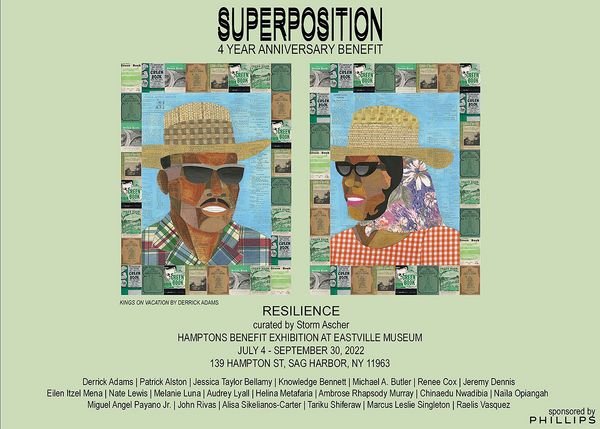Phillips is proud to sponsor Superposition Gallery's RESILIENCE, a celebration of both the gallery's fourth anniversary and its continued commitment to emerging artists from around the world. Taking place at the Eastville Museum in Sag Harbor, New York, the benefit sale highlights a wide range of visual responses to the curatorial theme of resilience, each showcasing the scope and intensity of the motif. Founder and director of Superposition Gallery Storm Ascher spoke with several featured artists about the ways in which they bring context, inspiration, and wider engagement to their unique perspectives on resilience.
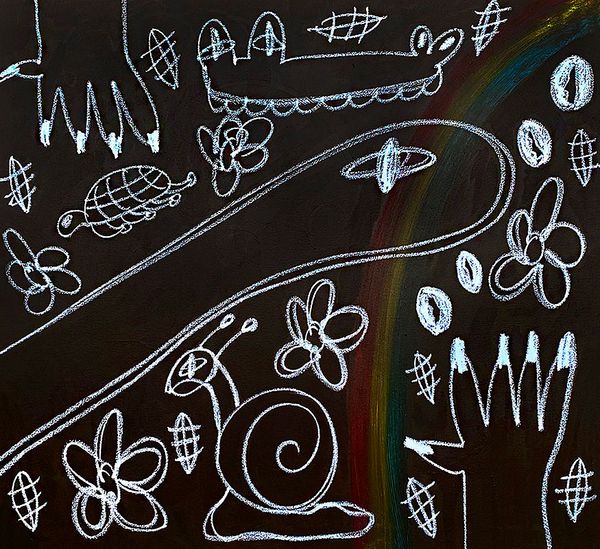
Eilen Itzel Mena, Through the Mud There is Clear Water (Bayou), 2021. RESILIENCE: Superposition 4 Year Anniversary Benefit.
EILEN ITZEL MENA
STORM ASCHER: Why did you choose to present this work for Superposition’s 4-year anniversary show, RESILIENCE?
EILEN ITZEL MENA: I chose this work for Superposition’s 4 year anniversary show and benefit, because the theme was in direct conversation with this painting. The work in this exhibition is a response to resilience as an emotion and physical act. It asks you to move through and with the crowd in order to access light from within and find clarity.
The title of the work is Through the Mud, there is Clear Water (Bayou). This work came as an emotional reaction to a family trip to New Orleans. While in Louisiana, we took a Bayou boat tour and got to take in the energy of this environment. As a child, I was often terrified of the dark and dark waters, so going to the Bayou became a grounding and healing experience. Although the waters were dark and muddy, I could feel a plethora of diverse wildlife co-existing in the swamp. It felt peaceful. I saw alligators and other animals above the surface of the bayou all sharing this space.
As our driver sped up the boat to go to another location in the swamp, I was entranced by the boat propellor churning opaque dark water, into a transparent clear liquid. Now I could see rocks and other small living beings through the mud. This moment transformed itself into a core memory and led to me writing down the phrase, through the mud there is clear water. This phrase became the starting point of a deeper conversation within me. Externally I created a work that displayed a diversity of living beings co-existing and floating under the surface of a swamp. A big flash of light, a rainbow, can be seen through the muddy water. Internally I was processing the ways in which resilience was necessary in my life. I felt moments where I had to churn away the mud and darkness in order to attain clarity and light. The result of this energetic transmutation is this work. Through the Mud there is Clear Water - a double entendre signifying the work and the transmuted energy at play.
SA: Can you think of a specific place in nature that you always go to in your mind to calm down?
EIM: Fresh water sources often come to mind when I want to find peace and clarity. Whether it’s in my mind or in person, the fluidity and clarity that comes out of these places cools my mind, body and spirit. Waterfalls are especially powerful to me. The controlled and steady movement of the water is grounding and reminds me of my personal power.
SA: What associations do you have when you think of summertime while growing up?
EIM: I associate the summers with the Dominican Republic and the Bronx. I attended The Hotchkiss School, a New England prep school and boarding school. Whenever I would have summer break, I would come back to the Bronx or go on 3 month family trips back to the Dominican Republic. The Bronx was a place for me to reconnect with my friends from New York, enjoy summer parties, basketball games, birthdays and cookouts. It was a place I also went back to as a Day camp counselor for a summer job as well. During the summertime in the Dominican Republic, I would spend time with my siblings, cousin and extended family. We would go to the beach, eat amazing food and enjoy the tropical weather. I often feel peaceful and grounded while in the Dominican Republic.
SA: Did you know about the BIPOC history of Sag Harbor? What other places in history do you think of as having historical BIPOC excellence?
EIM: I learned about the BIPOC history of Sag Harbor last year at the Superposition 3rd year anniversary show with Eastville Historical Society. I learned about the mixed race community of European Immigrants, Indigenous Americans and Black folks who all lived together in this place. We also went to the cemetery and saw that all of these groups were buried there as well. It was beautiful to learn of the history of this place, because in US History we don’t often learn of diverse communities like this and their histories. I am excited to learn more about Eastville and other historical BIPOC communities in the United States.
SA: What would you like to see the Eastville Museum archives accomplish?
EIM: I would like to see the Eastville Museum to expand its social media presence in order to educate younger generations on its archive. By doing so, their knowledge of this diverse historical community can spread on a larger scale and can show to others the importance of maintaining communities like this. Archives like this, their preservation and exhibition can expand our view of coexistence and history.
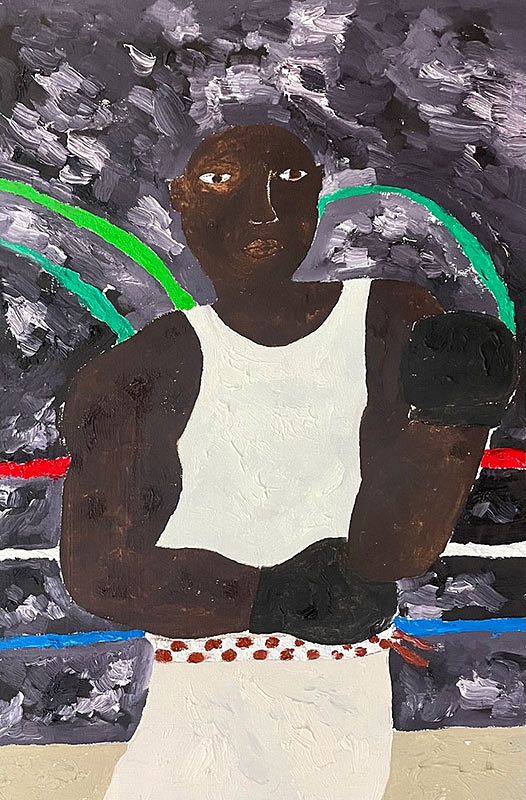
Marcus Leslie Singleton, Sparring, 2022. RESILIENCE: Superposition 4 Year Anniversary Benefit.
MARCUS LESLIE SINGLETON
STORM ASCHER: Why did you choose to present this work for Superposition’s 4-year anniversary show, RESILIENCE?
MARCUS LESLIE SINGLETON: The painting depicts a boxer in a stance of strength and grace. I thought this would be a great painting to have in conversation with the theme.
SA: Can you think of a specific place in nature that you always go to in your mind to calm down?
MLS: Any place by the water. And specifically by the ocean.
SA: What associations do you have when you think of summertime while growing up?
MLS: Our family did quite a few fishing trips. We also would visit our family that lived in California, those are really great memories.
SA: Did you know about the BIPOC history of Sag Harbor? What other places in history do you think of as having historical BIPOC excellence?
MLS: I was familiar with the black history of Sag Harbor, as well as Hudson, New York. There are many towns across the US that have black roots. I guess San Fransisco would be the best contemporary example as currently constructed it’s population is made up of young white tech and business workers. Originally those neighborhoods were black, now they have been mostly displaced.
SA: What would you like to see the Eastville Museum archives accomplish?
MLS: Would love to see the Museum continue to collect art by current black and BIPOC makers to make an extensive story throughout our history.
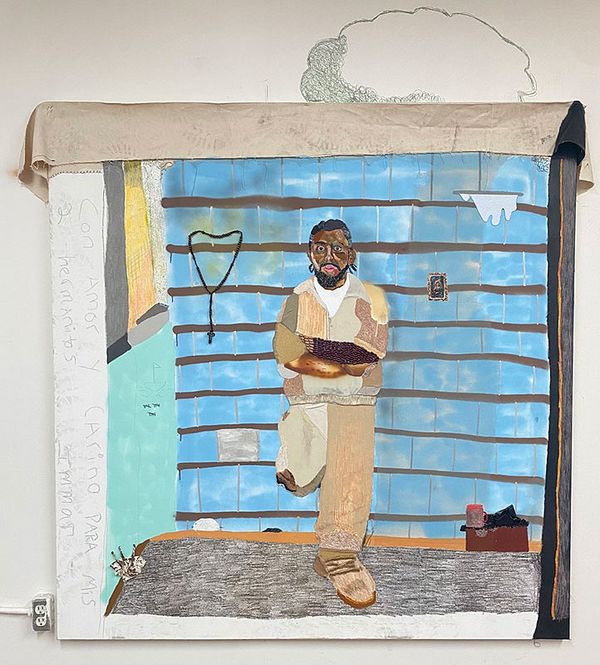
John Rivas, Locked up, they won’t let me out, 2022. RESILIENCE: Superposition 4 Year Anniversary Benefit.
JOHN RIVAS
STORM ASCHER: Why did you choose to present this work for Superposition’s 4-year anniversary show, RESILIENCE?
JOHN RIVAS: Once I saw the title of the show and understood the meaning of it, it kind of came all together, to be honest. I’ve been finding a way to express my feelings more about the man in the painting prior to being asked to be a part of this show. So, I read that and I was like: fuck, this is it. The man in the painting is my uncle. He was locked up when I was younger and once his time was done, he was deported back to El Salvador. Adapting and overcoming difficult and challenging life experiences. Not just mine, of someone who I love being ripped from me, and his experiences in turn. My uncle's life no longer became the world; it became four blocks of cement. A breaking point in his life but just another setback that he overcame.
SA: Can you think of a specific place in nature that you always go to in your mind to calm down?
JR: Recently it has been my fire escape. It faces the back side of the building and in the backyards of all the buildings in the block it’s full of trees. It’s a whole different world compared to the front side of the building. To ease my mind I put on some soothing tunes, light up a J, and focus on the now. Being grateful for the small things in life which are sometimes cloudy with the fast pace of society. Grateful to breathe, grateful to see, grateful to touch, and grateful to walk: this is my mantra to calm my mind.
SA: What associations do you have when you think of summertime while growing up?
JR: Carne asadas. Camping. Being laid back on a hammock at the lake and soccer games.
SA: Did you know about the BIPOC history of Sag Harbor? What other places in history do you think of as having historical BIPOC excellence?
JR: I actually didn’t know; it’s new to me and I should do more research of the history of Sag Harbor, since I see Storm speak about it so passionately; it has to be something we know, respect, and appreciate.
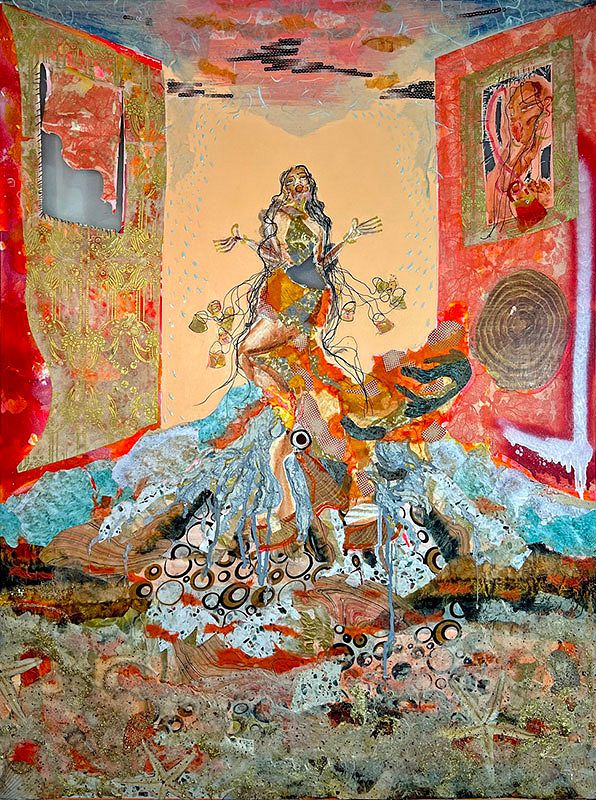
Audrey Lyall, Bring It All To Me, 2022. RESILIENCE: Superposition 4 Year Anniversary Benefit.
AUDREY LYALL
STORM ASCHER: Why did you choose to present this work for Superposition’s 4-year anniversary show, RESILIENCE?
AUDREY LYALL: I actually made this work specifically for RESILIENCE. When Storm told me about this year’s curation theme, I immediately envisioned a figure emerging from chaotic scenery, yet remaining regal and opulent. I participated in the Superposition x Eastville Benefit Exhibition in 2021, so I took inspiration from the delightful experience I had in Sag Harbor for this painting.
SA: Can you think of a specific place in nature that you always go to in your mind to calm down?
AL: I grew up in Northern California surrounded by nature, so I have fond memories of adventuring through Point Reyes and Bolinas with my childhood best friend, Sam. We were always finding new spots and having photoshoots. When I think of those memories, it feels like pure bliss.
SA: What associations do you have when you think of summertime while growing up?
AL: Growing up, summertime always felt like an opportunity for independence. I think of going on hikes, hanging out at different parks, and meeting new friends. As a young kid there was a playful innocence to the summertime, like having a lemonade stand in the neighborhood. However, the summertime definitely turned into an opportunity to get into all sorts of shenanigans as I got into my teen years.
SA: Did you know about the BIPOC history of Sag Harbor? What other places in history do you think of as having historical BIPOC excellence?
AL: I didn’t know about the BIPOC history of Sag Harbor until Storm asked me to be in the previous Eastville exhibition back in 2021. I didn’t know much about Sag Harbor in general as I had never been there before. It was such an invigorating surprise to learn about the rich history there in person with Dr. Georgette Grier-Key. I think that historical BIPOC excellence exists everywhere and always has. It’s hard to pinpoint one place because we have a huge impact worldwide.
SA: What would you like to see the Eastville Museum archives accomplish?
AL: I would like to see the Eastville Museum archives encapsulate the past and ongoing histories in Sag Harbor, so that generations to come can understand its legacy.
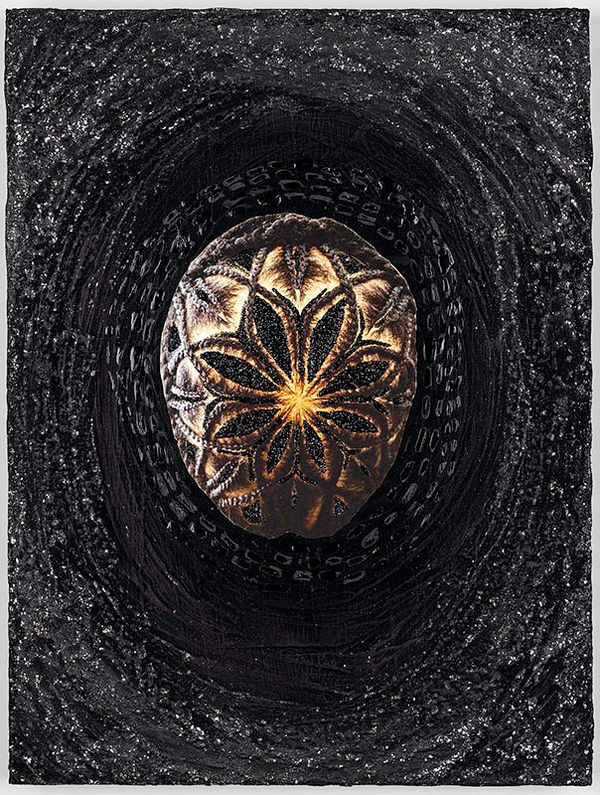
Alisa Sikelianos-Carter, Portrait of a Galaxy, 2021. RESILIENCE: Superposition 4 Year Anniversary Benefit.
ALISA SIKELIANOS-CARTER
STORM ASCHER: Why did you choose to present this work for Superposition’s 4-year anniversary show, RESILIENCE?
ALISA SIKELIANOS-CARTER: I chose Portrait of a Galaxy because there’s a strength in the imagery that I feel is synonymous with the concept of the show. It’s self-contained and whole. The piece depicts a cosmic system that has the ability to change and grow. Our hair is regenerative and resilient, and there’s an inherent power in braids and protective styling.
SA: Can you think of a specific place in nature that you always go to in your mind to calm down?
AS-C: I imagine myself lying in a boat on a lake at night; walking on the seafloor or swimming with whales and dolphins in the deep ocean.
SA: What associations do you have when you think of summertime while growing up?
AS-C: Lightning bugs, cookouts, swimming, music, rain.
SA: Did you know about the BIPOC history of Sag Harbor? What other places in history do you think of as having historical BIPOC excellence?
AS-C: I only just learned about it through this show. This speaks to the power of art as a storytelling device. I’m thrilled to know this history. The places that immediately come to mind are Harlem, Chicago, Detroit, D.C., and all of the Southern U.S. But honestly, we exist everywhere, and our excellence is woven into the fabric of tiny towns and cities all over the country.
SA: What would you like to see the Eastville Museum archives accomplish?
AS-C: A continued mission to highlight the contributions of Black and Indigenous people that have lived in the region for centuries.

Chinaedu Nwadibia, Nails is in Her Blood, 2020. RESILIENCE: Superposition 4 Year Anniversary Benefit.
CHINAEDU NWADIBIA
STORM ASCHER: Why did you choose to present this work for Superposition’s 4-year anniversary show, RESILIENCE?
CHINAEDU NWADIBIA: This piece serves as a container for some of the emotions that complement the idea of resilience: hope, confidence, joy, strain. In the case of Black people worldwide, these emotional states have been experienced all at once and blanketed in style and grace.
SA: Can you think of a specific place in nature that you always go to in your mind to calm down?
CN: I go to a beach augmented by my imagination. Warm, sparkling and sun-drenched. The sand is so fine it cushions your feet like a custom insole, glistening with every tilt of one’s head. The water is clear enough for you to reach down and collect your own Eke pearls (they harness unlimited clean, safe energy), and everyone takes only as much as they need, never forgetting to clean up behind themselves, coming and going with gratitude.
SA: What associations do you have when you think of summertime while growing up?
CN: Hot weather, No AC and drinking – guzzling from the water hose on the side of anyone's house.
SA: Did you know about the BIPOC history of Sag Harbor? What other places in history do you think of as having historical BIPOC excellence?
CN: I did not know about the historical BIPOC legacy in Sag Harbor, so I’m glad that being an artist exposes me to impactful knowledge like this. Los Angeles is #1 on my list for multicultural historical greatness; every corner of the world had brought its influence to the city for generations.
SA: What would you like to see the Eastville Museum archives accomplish?
CN: I would like to see them secure consistent reliable funding so that they can focus on the important archival work that is needed to ensure these BIPOC histories are not lost or forgotten.

Jeremy Dennis, Manitou Hill, 2017. RESILIENCE: Superposition 4 Year Anniversary Benefit.
JEREMY DENNIS
STORM ASCHER: Why did you choose to present this work for Superposition’s 4-year anniversary show, RESILIENCE?
JEREMY DENNIS: Thinking about resilience, I think about my lineage and ancestry being Shinnecock and how we have survived over 300 years of colonization and found a way to live on what is known as Long Island, New York, for thousands of years before that. It was thanks to ancestral knowledge, hope for the future, and taking care of local resources. Manitou Hill represents both struggle and resilience – it depicts a scene from one of our local Algonquian creation stories in which a Sachem (or leader) calls to the Great Creator to quench a desperate thirst for water for the people.
SA: Can you think of a specific place in nature that you always go to in your mind to calm down?
JD: My place of calm is the ocean; it is a big reason why many people have moved and live on the East End full time. For me, it is the humbling feeling of seeing something so large and connecting and recognizing my place in the scale of the world. The sound of the ocean is calming year-round, and it brings happiness and relief in the hot summers.
SA: What associations do you have when you think of summertime while growing up?
JD: Throughout summer, different Native Nations host their own annual powwow – I often think of the different memories of traveling between the various powwows and of course the annual Labor Day Weekend Powwow with many family members who live far away and come back for this special time of gathering and celebration each year.
SA: Did you know about the BIPOC history of Sag Harbor? What other places in history do you think of as having historical BIPOC excellence?
JD: I am grateful to the work of Dr. Georgette Greer-Key for bringing the important BIPOC history forward in Sag Habor; for me, there is still much to learn and appreciate in my understanding. We need to appreciate and highlight the historic contributions of all peoples, but people of color are often marginalized. It is inspiring that local institutions such as Eastville, Southampton African American Museum, OLA, Teatro Yerbabruja, and others are emerging and thriving with more support.
SA: What would you like to see the Eastville Museum archives accomplish?
JD: I would like to see artist-researchers working with the Eastville Museum archives to establish new interpretations and creative ways of presenting this important history.
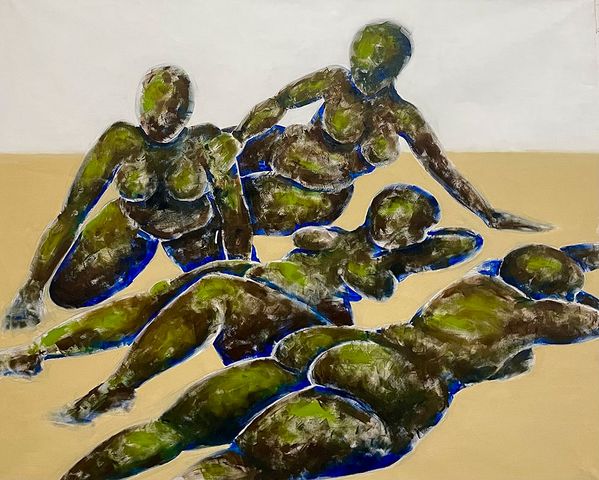
Naîla Opiangah, Trouble waters won’t make troubled Memories, 2022. RESILIENCE: Superposition 4 Year Anniversary Benefit.
NAILA OPIANGAH
STORM ASCHER: Why did you choose to present this work for Superposition’s 4-year anniversary show, RESILIENCE?
NAILA OPIANGAH: Resilience is a term that I've struggled with over the past two years. I spent most of my life considering it as a symbol of pride and accomplishment. After moving to the US, going through college, working and experiencing corporate culture as a Black woman, resilience became a sort of ID card. I would look at that card and remind myself that every situation was worth it, every pain and tribulation, justified and unjustified, was a necessary rite of passage to be the strong person I am today, to feel the worth I feel today. In 2020, I started questioning that ideology. I started seeing the exploitative undertones embedded within the term resilience. The idea that one must celebrate a painful process as if that process was the only possible path, while simultaneously witnessing others enjoy much less tumultuous rides towards the same destination, is a cult of unfairness and fundamental inequity. I still appreciate the good qualities that resilience represents. In fact, I still feel pride in my resilience and the resilience of my community. I nonetheless would like to invite more nuanced perspectives to the idea of resilience, and that is why I was very pleased to participate in this show. The two works that I am presenting are an invitation to nuance. They're conceptual interpretations of my relationship with resilience, my understanding of the historical and urban context in which we are showing.
SA: Can you think of a specific place in nature that you always go to in your mind to calm down?
NO: Bodies of water and waterfronts are very calming to me.
SA: What associations do you have when you think of summertime while growing up?
NO: I grew up in Libreville, Gabon. Being a tropical country, it doesn't offer a dramatic change of seasons. The summertime in northern countries is the dry season in Gabon. Temperatures are just a tiny bit lower, but not so different that it would affect regular outdoor activities. It is also the longest school break; families who could afford it would travel abroad a lot or travel to the countryside. What I associate with that time growing up is rest, airplanes, Mounana, sleepovers at cousins' houses, endless TV sessions, endless reading sessions, toys, le bord de mer, the beach, the neighborhood store, the neighbors' houses, my cousin's neighbors' houses, endless rest.
SA: Did you know about the BIPOC history of Sag Harbor? What other places in history do you think of as having historical BIPOC excellence?
NO: The first time I learned about the BIPOC history in Sag Harbor was in 2020 when I came across a short documentary by Joshua Kissi for the New York Times. It highlighted the stories of the Black residents of Sag Harbor and how their community grew from the late 19th century. That is a significant part of history that I wish I had known more about. There are many other places of historical BIPOC excellence throughout the US that I would love to know more about, especially towns built near bodies of water, such as Sag Harbor. I relate to these communities a lot because of my hometown of Libreville. Translating to Free Town, my city was built by former enslaved people of southern Gabon who were bound to be sent on the transatlantic slave trade. Today Libreville is the capital of Gabon and a driving economic force in central Africa.
SA: What would you like to see the Eastville Museum archives accomplish?
NO: Archiving is a powerful form of preservation and therefore liberation. I would like for the Eastville Museum to have the needed tools to amplify the stories of the BIPOC community in Sag Harbor. I would like to see more institutional partnerships that will help broaden the museum's platform in order to reach more people across the world. I am happy that the museum gave me, a Gabonese artist, the opportunity to contribute to its mission, leading me to participate in its larger archival work.

Helina Metaferia, Crowning Care I, 2021. RESILIENCE: Superposition 4 Year Anniversary Benefit.
HELINA METAFERIA
STORM ASCHER: Why did you choose to present this work for Superposition’s 4-year anniversary show, RESILIENCE?
HELINA METAFERIA: These two collages are from my By Way of Care series, which was a year-long commissioned project by the curatorial team Designing Motherhood, where I worked with doulas and birth workers of the Maternity Care Coalition in Philadelphia through a performance workshop designed to care for those that give care. Two of the birth workers who participated in the workshop were photographed for my collages, which crowned them with archives from the organization's 40-year history of providing support to pregnant women and young children. This project is a sequel to my current project, By Way of Revolution, which focuses on undertold activist legacies of women in social justice movements. Both projects look at the politics of care and the often-invisible labor of BIPOC women’s contributions to society. I wanted to share these two collages for Superposition's show about resilience, because what's more resilient than mothers, and those who care for them?
SA: Can you think of a specific place in nature that you always go to in your mind to calm down?
HM: I love being near trees and water. There's something rejuvenating about being away from the hustle of the city and immersed in natural environments. Some of my best artwork was made during and after I spent extended time in nature.
SA: What associations do you have when you think of summertime while growing up?
HM: My birthday is in June, so I remember feeling happiest in the summer as a kid. My childhood memories of summer include birthday parties, leisure, fireflies, summer reading, beaches, pools, barbeques, and occasionally visiting relatives in Ethiopia, where my family is from. As a younger artist, I always knew how to use my creativity to fill my time up, especially in the summer. Now, as a professional artist, I often draw from that sense of play to make my work.
SA: Did you know about the BIPOC history of Sag Harbor? What other places in history do you think of as having historical BIPOC excellence?
HM: As an artist who works a lot with historical archives, I am interested in unearthing empowering stories that uplift BIPOC people, particularly women. I am learning more about Sag Harbor's BIPOC history through Superposition Gallery. There's so much Native American, African American, and immigrant history throughout this country, and America's legacy couldn't be told without it. As we know, history is subjective, and is often told from the perspective of the oppressor. Artists have a platform that can intervene upon this and help us rethink what we have been taught.
SA: What would you like to see the Eastville Museum archives accomplish?
HM: There is joy and play in archiving. Documentation does not have to be static, it can be a living, breathing thing that evolves through interpretation. I hope that the Eastville Museum finds enriching, engaging ways to preserve and display its history, so that more people can foster connections with this region and each other.
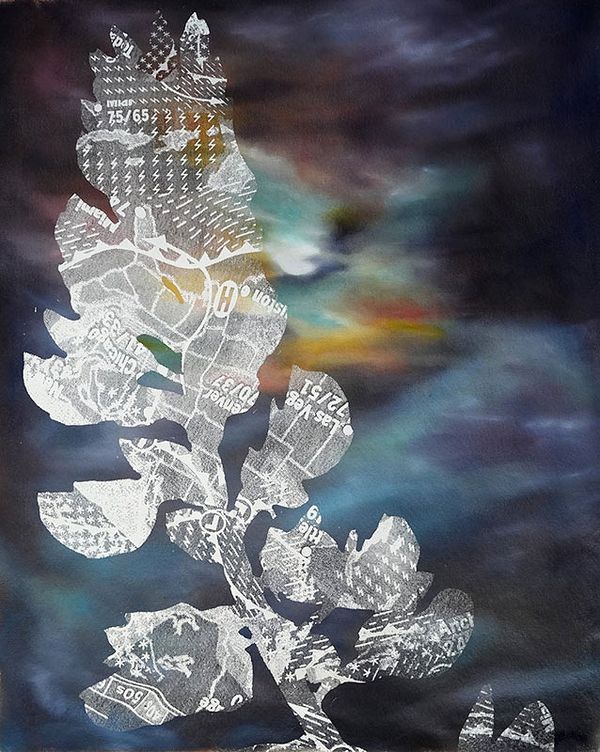
Jessica Taylor Bellamy, Solstice (Spider Lupine), 2022. RESILIENCE: Superposition 4 Year Anniversary Benefit.
JESSICA TAYLOR BELLAMY
STORM ASCHER: Why did you choose to present this work for Superposition’s 4-year anniversary show, RESILIENCE?
JESSICA TAYLOR BELLAMY: The screenprint on top of the painting is of a spider lupine silhouette, a native west coast flower growing from Mexico to Oregon, and a fire follower (meaning it has the ability to grow in recently charred areas and is itself resilient). The lupine is made up of manipulated "weather in the US today" maps from the LA Times, which I have been collecting in my studio along with other parts of the paper to create my own archive of time in a particular place.
SA: Can you think of a specific place in nature that you always go to in your mind to calm down?
JTB: It's always the ocean.
SA: What associations do you have when you think of summertime while growing up?
JTB: Bodyboarding in Manhattan Beach, CA (now I know I was at Bruce's Beach but didn't at the time). Pool parties. Otter pops. Sleepovers with friends. Extra time with my grandparents, who were an early creative source of inspiration and helped me get interested in casting, woodworking, and painting.
SA: Did you know about the BIPOC history of Sag Harbor? What other places in history do you think of as having historical BIPOC excellence?
JTB: I didn't until working with Storm and Superposition, and then seeing Amy Sheralds work in Great American Fact at Hause Wirth made me think of Sag Harbor, weather it was the setting for her paintings or not. The Venice-Oakwood area comes to mind as another historically Black beach neighborhood that has trickled away over the years with gentrification.
SA: What would you like to see the Eastville Museum archives accomplish?
JTB: Connecting the past with the present and finding creative ways to share the research and archives.
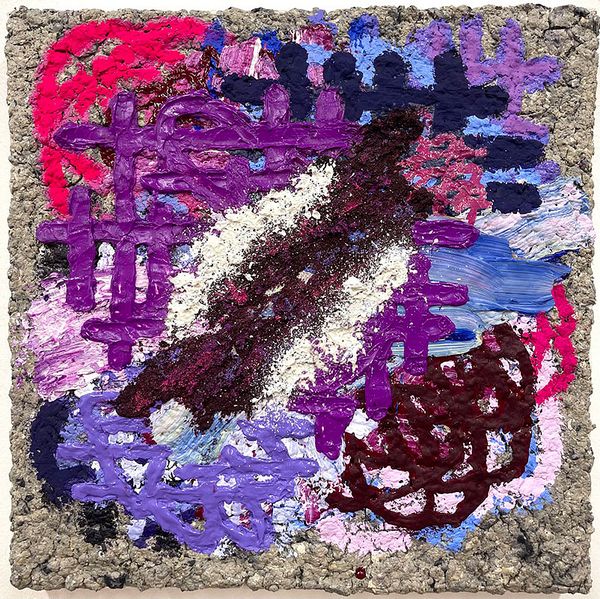
Patrick Alston, Despite it All , 2022. RESILIENCE: Superposition 4 Year Anniversary Benefit.
PATRICK ALSTON
STORM ASCHER: Why did you choose to present this work for Superposition’s 4-year anniversary show, RESILIENCE?
PATRICK ALSTON: I chose this work for the exhibition because it directly reflects the title of the exhibition. The work comes from a series that was inspired by a poem from the late great Tupac Shakur titled The Rose That Grew from Concrete. The work is created with handmade paper that references concrete’s textural essence, juxtaposed by colors and mark making that exhibit the struggle yet beauty of overcoming one’s direct environment. I see these works as self-portraits.
SA: Can you think of a specific place in nature that you always go to in your mind to calm down?
PA: I do not separate human made structure from those that occur in what is generally understood as nature. As ants may build mounds, humans create dwellings that exist, not in nature, but within nature. To calm my mind, I go to a place called home, where my loved ones exist. No ocean view or river scene can replace a Saturday morning at home, with the sun shining and my son smiling. That’s what stills me. It brings me back down to earth and connects me to what is truly valuable in life.
SA: What associations do you have when you think of summertime while growing up?
PA: My childhood in the South Bronx is what immediately comes to mind. I grew up in a special time when our water parks were the closest fire hydrant. Sounds of dirt bikes, smells of grilled food, games of tag, red light green light, and Chinese handball lasted all day and night. Much simpler times.
SA: Did you know about the BIPOC history of Sag Harbor? What other places in history do you think of as having historical BIPOC excellence?
PA: I did not know of the BIPOC history of Sag Harbor, but I was excited to learn about this hidden gem. The place that comes to mind is Tulsa, Oklahoma. A vibrant example of a city with thriving businesses and self-sustainability that still serves as an illustration of excellence.
SA: What would you like to see the Eastville Museum archives accomplish?
PA: I would like to see a continued story of the development of the Eastville BIPOC community’s legacy into the future.

Tariku Shiferaw, Fun! (Vince Staples), 2020. RESILIENCE: Superposition 4 Year Anniversary Benefit.
TARIKU SHIFERAW
STORM ASCHER: Why did you choose to present this work for Superposition’s 4-year anniversary show, RESILIENCE?
TARIKU SHIFERAW: Because I believe in Storm and what she's doing.
SA: Can you think of a specific place in nature that you always go to in your mind to calm down?
TS: The ocean or to a body of water. I grew up in LA, so my siblings and I went to the beach quite often. It's always been a place of rest for me.
SA: Can you think of a specific place in nature that you always go to in your mind to calm down?
TS: The beach! The beach was the only place that we could afford since it was free. My family and I went to Venice Beach every Saturday and Sunday for leisure during the summer. That was an important part of our summer pastime.
SA: Did you know about the BIPOC history of Sag Harbor? What other places in history do you think of as having historical BIPOC excellence?
TS: No, I did not. I'd be honest, I don't know many other places with history of BIPOC communities with a component of leisure.
SA: What would you like to see the Eastville Museum archives accomplish?
TS: I would like to see a permanent representation of Black and Brown artists in their archives, but I also think that this exhibition provides that possibility. A possibility to refer to all Black and Brown artists that have exhibited in the institution.

Ambrose Rhapsody Murray, Against gauguin, infrared gaze, 2022. RESILIENCE: Superposition 4 Year Anniversary Benefit.
AMBROSE RHAPSODY MURRAY
STORM ASCHER: Why did you choose to present this work for Superposition’s 4-year anniversary show, RESILIENCE?
AMBROSE RHAPSODY MURRAY: This work includes small images of some of Guagin's paintings (of nude Polynesian girls) and an archival photograph of a nude West African woman in the center, all digitally manipulated, and backed by a vintage kantha quilt from the Bengali region of India. This piece tells a story about the relationship between colonialism, art and sexual exploitation that is inherent to artists like Gaugin's work. This work shines light on the connections between girls and women across continents impacted by European colonialism, and how our histories are so intimately connected – materially, physiologically, and beyond.
SA: Can you think of a specific place in nature that you always go to in your mind to calm down?
ARM: By the water. Especially crystal-clear turquoise and blue waters.
SA: What associations do you have when you think of summertime while growing up?
ARM: Florida, hot sun, chlorine pools, lemonade, family, growing up, amusement parks, drawing.
SA: Did you know about the BIPOC history of Sag Harbor? What other places in history do you think of as having historical BIPOC excellence?
ARM: I wasn't aware of the history until I learned about the exhibition and Storm's work here. But I'm not surprised. From Central Park in NYC to my hometown of Asheville, North Carolina, rich histories of Black communities and our subsequent displacement are often erased and invisiblized. In my hometown, the city used eminent domain to take land away from a large Black neighborhood in the 70s. Their houses and neighborhood were replaced with mostly parking lots, including parking for the police. Today, there is not even a placard to memorialize or repair that history. The city is talked about as progressive and a front-runner in "reparations," but much of it is a sociopolitical performance.
SA: What would you like to see the Eastville Museum archives accomplish?
ARM: I hope they can accomplish their goals in preserving the legacy of Black people and their histories in Sag Harbor in whichever form best serves the people who are from the area or whose ancestors have connections there, as well as unburying the often hidden and erased legacies of Indigenous sovereignty that are tied to the land.
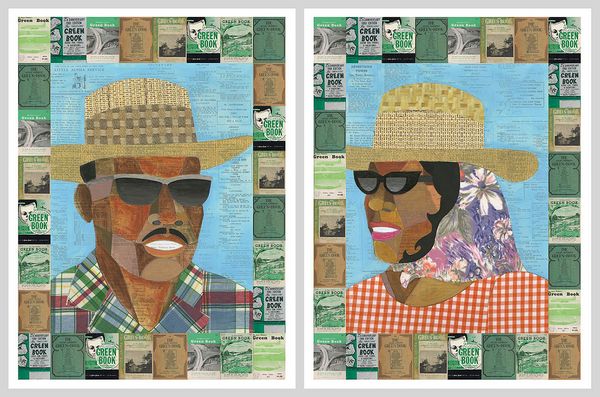
Derrick Adams, Kings on Vacation (diptych), 2021. RESILIENCE: Superposition 4 Year Anniversary Benefit.
DERRICK ADAMS
STORM ASCHER: Why did you choose to present this work for Superposition’s 4-year anniversary show, RESILIENCE?
DERRICK ADAMS: I believe in community. I'm fully dedicated to supporting my Black community, both here and abroad. We are in need of continuous support. As an artist, I'm committed to building up my community by offering my gifts if that will help. Superposition’s 4-year anniversary show, RESILIENCE, is also in line with that concept. I'm here for that.
SA: Can you think of a specific place in nature that you always go to in your mind to calm down?
DA: Although being in nature is more associated with the idea of retreat, the inner city is the most calming space for me. It is where I feel most relaxed, most connected with my local community. Sometimes I just walk outside, sit under a tree on a bench in my hood and catch a breeze and people watch.
SA: What associations do you have when you think of summertime while growing up?
DA: Growing up in Baltimore I spent most of my summer vacation hanging out at my neighborhood recreation center's summer camp which kept me pretty entertained most of the day while my parents were at work. Everyone knew everybody there. It was filled with many activities and I got to spend fun time with my friends.
SA: Did you know about the BIPOC history of Sag Harbor? What other places in history do you think of as having historical BIPOC excellence?
DA: I know of the rich history of the Sag Harbor Black American community and their success in establishing a space for retreat. There have been so many amazing places created for us by individuals and groups who understood the benefits of us having places for us to enjoy each other's company. Some are no longer around. One very important historical place was Paradise Park.
SA: What would you like to see the Eastville Museum archives accomplish?
DA: I feel now, more than ever it's essential that we archive our history, past, present, and future. With gentrification happening so rapidly these days, archiving is also a way to track geographical movement of cultural groups who have established communities that are all changing and could be disconnected from the founding principle.

Renee Cox, Springs WinterWonderland, 2021. RESILIENCE: Superposition 4 Year Anniversary Benefit.
RENEE COX
STORM ASCHER: Why did you choose to present this work for Superposition’s 4-year anniversary show, RESILIENCE?
RENEE COX: I chose this work as it was shot in the Springs, it represents a departure from my more traditional work as I am now reimagining my photographs via the use of animation. Also, this image ties into the African American history of the area.
SA: Can you think of a specific place in nature that you always go to in your mind to calm down?
RC: The forest.
SA: What associations do you have when you think of summertime while growing up?
RC: The ocean.
SA: Did you know about the BIPOC history of Sag Harbor? What other places in history do you think of as having historical BIPOC excellence?
RC: Martha’s Vineyard, Portland, Jamaica (Queen Nanny).
SA: What would you like to see the Eastville Museum archives accomplish?
RC: A wider outreach to white, Black children, and so on; for example, a Sunday School to teach African American History in order to increase awareness between the different groups.
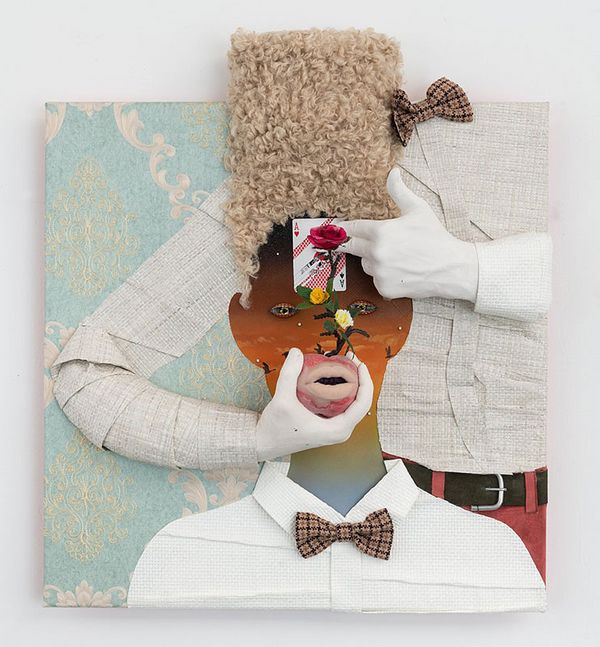
Miguel Ángel Payano Jr, I Am You, 2022. RESILIENCE: Superposition 4 Year Anniversary Benefit.
MIGUEL ANGEL PAYANO JR
STORM ASCHER: Why did you choose to present this work for Superposition’s 4-year anniversary show, RESILIENCE?
MIGUEL ANGEL PAYANO JR: The concept of resilience is very much a part of my creative process. In my studio, whether 2D, 3D or artworks in-between 2 and 3D, the final piece is always what has endured the creative process. Throughout its formation the artwork undergoes several stages of deconstruction and reconstruction, before it arrives to its resolved self. For me, arriving to a “finished” artwork is a process of disruption and discovery.
For this exhibition, I elected to create heavy collages, a term I use to describe artworks which incorporate elements of painting, collage and relief sculpture. Among my different modes of working, creating heavy collages is the mode that has taken the longest to develop. After a nearly two decade long art practice in China, I returned to New York in 2016 with the intention of deconstructing and rebuilding my practice. In way, this mode of working is the resilience of an art practice. It is a resolved way of working that followed a process of deconstruction.
SA: Can you think of a specific place in nature that you always go to in your mind to calm down?
MAPJ: In fact, I often find solace and comfort at the beach. The sound of the ocean, a seaside sunset, warm sun and gentle breeze have always been soothing. Deeper still, sitting on the sand and gazing out onto the water and horizon inspires contemplation on not just my own life, but life on this planet and beyond. It is like I'm looking into the sublime. The theory of evolution purports that life on this planet arose out of the ocean over long lengths of time, further, the immense power of the ocean results from the magnetic pull between the earth and moon—distant and huge cosmic bodies in an infinitely larger universe. Considering phenomenon of such scales is always humbling for me. It makes any challenge that I may face seem insignificant and I find comfort and liberation in that. Throughout my travels, if the ocean is nearby, I will often adjust my itinerary to accommodate a visit—it never fails to recenter me.
SA: What associations do you have when you think of summertime while growing up?
MAPJ: As a child and throughout much of my schooling the summertime had always been a time for extra training, whether that be athletics, education or gaining new life experiences. And even from an early age, what I did during the summertime was often self-initiated. Reflecting on it more now, the summer has always been a time for self-actualization and honing in on my core interests.
SA: Did you know about the BIPOC history of Sag Harbor? What other places in history do you think of as having historical BIPOC excellence?
MAPJ: I knew nothing about Sag Harbor’s history until this project. This just shows the need and importance of such initiatives. There is so much history in this country and through-out the world that hasn’t been recorded and not from of lack of documentation and accounts, but from grossly skewed focus on what has been deemed important. Despite all the problems we face, I do feel hopeful about this point. I feel like en masse people in this country and globally people are becoming more aware in general and specifically about filling in the gaping holes in “his-story”.
SA: What would you like to see the Eastville Museum archives accomplish?
MAPJ: One thing which the museum is doing already is dig deep into it’s own regional history. I think that it’s always good to remind ourselves that history is also the present moment in the distant future. The museum not only has the possibility to keep record of artist careers and development, but also has the possibility to directly communicate with living artists. This accessibility also allows artists to tell their own stories as well as provide future audiences and scholars with more personal and intimate information about the lives and their works.
RESILIENCE will take place at 139 Hampton Street, Sag Harbor, New York, and has been extended through December. For more information regarding how to support this initiative please contact storm@superpositiongallery.com
Discover More from RESILIENCE: Superposition 4 Year Anniversary Benefit >
